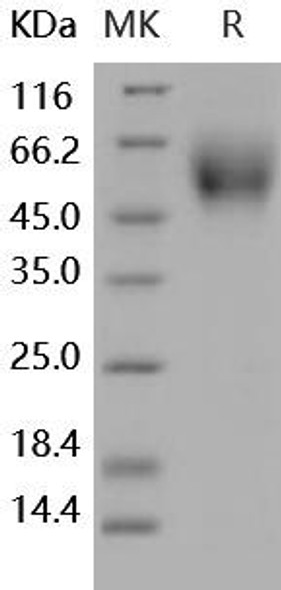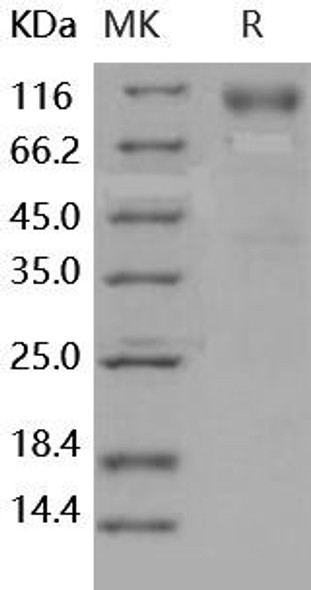Description
Recombinant Human TNFRSF21/DR6/CD358 Protein
The Recombinant Human TNFRSF21/DR6/CD358 Protein is a biologically active recombinant protein that plays a significant role in various cellular processes and signaling pathways in human biology. This protein is widely employed in immunological research, cell biology studies, protein-protein interaction analyses, and therapeutic development, providing researchers with a reliable tool for investigating TNFRSF21/DR6/CD358 function and its implications in health and disease.
This product (SKU: RPCB0949) is produced using HEK293 cells and features a C-hFc&His tag for convenient detection and purification. The protein exhibits a calculated molecular weight of 60.37 kDa with an observed molecular weight of 95-110 kDa under denaturing conditions, achieving ≥ 95 % as determined by SDS-PAGE.. Functional bioactivity has been validated through rigorous quality control assays, confirming its suitability for demanding research applications.
Key Features
| High Purity by Affinity Chromatography | |
| Mammalian & Bacterial Expression Systems | |
| High lot-to-lot consistency via strict QC |
| Product Name: | Recombinant Human TNFRSF21/DR6/CD358 Protein |
| SKU: | RPCB0949 |
| Size: | 10 μg , 20 μg , 50 μg , 100 μg |
| Reactivity: | Human |
| Synonyms: | TNFRSF21, BM-018, CD358, DR6 |
| Tag: | C-hFc&His |
| Expression Host: | HEK293 cells |
| Calculated MW: | 60.37 kDa |
| Observed MW: | 95-110 kDa |
| Gene ID: | 27242 |
| Protein Description: | High quality, high purity and low endotoxin recombinant Recombinant Human TNFRSF21/DR6/CD358 Protein (RPCB0949), tested reactivity in HEK293 cells and has been validated in SDS-PAGE.100% guaranteed. |
| Endotoxin: | < 1 EU/μg of the protein by LAL method. |
| Purity: | ≥ 95 % as determined by SDS-PAGE. |
| Formulation: | Lyophilized from a 0.22 μm filtered solution of PBS, pH 7.4. |
| Bio-Activity: | Measured by its binding ability in a functional ELISA.Immobilized Human APP at 10 μg/mL (100 μL/well) can bind Mouse DR6 with a linear range of 0.002-1.8 μg/mL. |
| Reconstitution: | Centrifuge the vial before opening. Reconstitute to a concentration of 0.1-0.5 mg/mL in sterile distilled water. Avoid vortex or vigorously pipetting the protein. For long term storage, it is recommended to add a carrier protein or stablizer (e.g. 0.1% BSA, 5% HSA, 10% FBS or 5% Trehalose), and aliquot the reconstituted protein solution to minimize free-thaw cycles. |
| Storage: | Store at -20℃.Store the lyophilized protein at -20℃ to -80 ℃ up to 1 year from the date of receipt. After reconstitution, the protein solution is stable at -20℃ for 3 months, at 2-8℃ for up to 1 week. |
Tumor necrosis factor receptor superfamily member 21 (TNFRSF21) is also known as death receptor 6 (DR6), which is a member of the TNF-receptor superfamily.This type I transmembrane receptor possesses four extracellular cysteine-rich motifs and a cytoplasmic death domain. DR6 is an extensively posttranslationally modified transmembrane protein and that N- and O-glycosylations of amino acids in its extracellular part. DR6 interacts with the adaptor protein TRADD and mediates signal transduction through its death domain, and expression of DR6 in mammalian cells induces activation of both NF-kappaB and JNK and cell apoptosis. DR6 knockout mice have enhanced CD4+ T cell proliferation and Th2 cytokine production, suggested that DR6 serves as an important regulatory molecule in T-helper cell activation, and is involved in inflammation and immune regulation. DR6 is expressed ubiquitously with high expression in lymphoid organs, heart, brain and pancreas. Some tumor cells overexpress DR6, typically in conjunction with elevated anti-apoptosis molecules. DR6 may also be involved in tumor cell survival and immune evasion, which is subject to future investigations.








